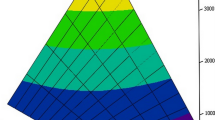Conclusions
-
1.
The number of simultaneously growing dendrites determined by plotting profilometer records of basis metal surfaces is in good agreement with the value obtained with an electron microscope, which is of the order of 106 per 1 cm2 of cathode surface [5].
-
2.
The character of growth of a dispersed deposit is largely determined by the conditions under which hydrogen evolution takes place on the electrode surface. The magnitude of hydrogen evolution polarization, which is determined by the nature of the basis material and the true surface of the electrode (its profile), controls the character of current density variation on the tips of dendrites, i.e., the rate of their growth. The greater the hydrogen overvoltage on a given material (vitreous carbon) and the smaller the active surface of the material (a gauze electrode) the higher is the rate of growth of dendrites, resulting in the formation of finer powders.
Similar content being viewed by others
Literature cited
J. W. Diggle, A. R. Despič, and J. O'M. Bockris, “Process of dendritic electrocrystallization of zinc,” J. Electrochem. Soc.,116, 1503–1521 (1969).
A. R. Despič and M. M. Purenovic, “Critical overstressing and inductive time of den-drite growth,” J. Electrochem. Soc.,121, 329–341 (1974).
A. V. Pomosov, “Some characteristics of the electrodeposition of lead powder,” in: Chemical Technology and Production Control [in Russian], Tr. Uralsk. Politekh. Inst., Sverdlovsk, No. 96, 63–69 (1960).
A. V. Pomosov and E. E. Krymakova, “Prognostication of the properties of electrolytic copper powder,” Poroshk. Metall., No. 6, 1–4 (1976).
R. D. Naybour, “Morphologies of zinc electrodeposited from zinc-saturated aqueous alkaline solution,” Electrochim. Acta,13, 763–769 (1968).
Author information
Authors and Affiliations
Additional information
Translated from Poroshkovaya Metallurgiya, No. 1 (181), pp. 1–6, January, 1978.
Rights and permissions
About this article
Cite this article
Pomosov, A.V., Murashova, I.B., Vorob'ev, V.I. et al. Effect of the character of the cathode surface on the growth kinetics of dispersed copper deposits. Powder Metall Met Ceram 17, 1–5 (1978). https://doi.org/10.1007/BF00795127
Received:
Issue Date:
DOI: https://doi.org/10.1007/BF00795127




